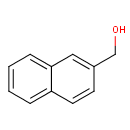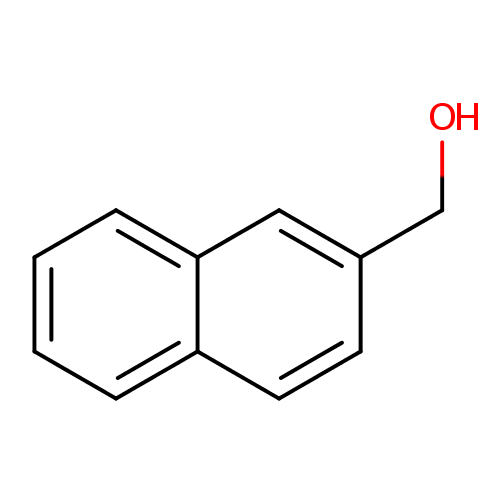|
Record Information |
|---|
| Version |
1.0 |
|---|
| Update Date |
1/22/2018 11:54:54 AM |
|---|
|
Metabolite ID | PAMDB000856 |
|---|
|
Identification |
|---|
| Name: |
(2-Naphthyl)methanol |
|---|
| Description: | (2-naphthyl)methanol is a member of the chemical class known as Naphthalenes. These are compounds containing a naphthalene moiety, which consists of two fused benzene rings. |
|---|
|
Structure |
|
|---|
| Synonyms: | - (naphthalen-2-yl)methanol
- 2-Hydroxymethylnaphthalene
- 2-Naphthalene methonal
- 2-Naphthalenemethanol
- 2-Naphthylmethanol
- Naphthalen-2-yl-methanol
|
|---|
|
Chemical Formula: |
C11H10O |
|---|
| Average Molecular Weight: |
158.1965 |
|---|
| Monoisotopic Molecular
Weight: |
158.073164942 |
|---|
| InChI Key: |
MFGWMAAZYZSWMY-UHFFFAOYSA-N |
|---|
| InChI: | InChI=1S/C11H10O/c12-8-9-5-6-10-3-1-2-4-11(10)7-9/h1-7,12H,8H2 |
|---|
| CAS
number: |
1592-38-7 |
|---|
| IUPAC Name: | naphthalen-2-ylmethanol |
|---|
|
Traditional IUPAC Name: |
2-naphthalenemethanol |
|---|
| SMILES: | OCC1=CC2=CC=CC=C2C=C1 |
|---|
|
Chemical Taxonomy |
|---|
|
Taxonomy Description | This compound belongs to the class of organic compounds known as naphthalenes. These are compounds containing a naphthalene moiety, which consists of two fused benzene rings. |
|---|
|
Kingdom |
Organic compounds |
|---|
| Super Class | Benzenoids |
|---|
|
Class |
Naphthalenes |
|---|
| Sub Class | Not Available |
|---|
|
Direct Parent |
Naphthalenes |
|---|
| Alternative Parents |
|
|---|
| Substituents |
- Naphthalene
- Hydrocarbon derivative
- Aromatic alcohol
- Primary alcohol
- Organooxygen compound
- Alcohol
- Aromatic homopolycyclic compound
|
|---|
| Molecular Framework |
Aromatic homopolycyclic compounds |
|---|
| External Descriptors |
|
|---|
|
Physical Properties |
|---|
| State: |
Solid |
|---|
| Charge: | 0 |
|---|
|
Melting point: |
81.3 °C |
|---|
| Experimental Properties: |
|
|---|
| Predicted Properties |
|
|---|
|
Biological Properties |
|---|
| Cellular Locations: |
Cytoplasm |
|---|
| Reactions: | |
|---|
|
Pathways: |
- Microbial metabolism in diverse environments pae01120
- Naphthalene degradation pae00626
|
|---|
|
Spectra |
|---|
| Spectra: |
|
|---|
|
References |
|---|
| References: |
- Kanehisa, M., Goto, S., Sato, Y., Furumichi, M., Tanabe, M. (2012). "KEGG for integration and interpretation of large-scale molecular data sets." Nucleic Acids Res 40:D109-D114. Pubmed: 22080510
|
|---|
| Synthesis Reference: |
Not Available |
|---|
| Material Safety Data Sheet (MSDS) |
Not Available |
|---|
|
Links |
|---|
| External Links: |
|
|---|


